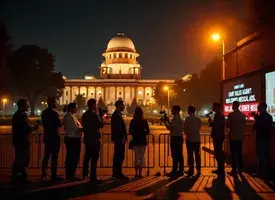By Apalka Bareja and Aishwarya Rajput
Introduction
In an era defined by rapid digital dissemination of information, advertising profoundly influences consumer decisions. While responsible advertising serves as a vital conduit for public awareness, the proliferation of misleading medical advertisements presents a grave threat, potentially leading to significant financial losses, the shattering of false hopes, and, most critically, severe health hazards.
Recognizing the profound public interest at stake, the Hon’ble Supreme Court of India has initiated a robust drive to combat deceptive medical advertisements and enforce stringent compliance with existing legal frameworks.[1] Over recent months, the Apex court has issued a series of directives, signalling a resolute commitment to foster a more transparent and accountable advertising ecosystem within the healthcare sector.
Supreme Court’s Directives on Misleading Medical Ads
The judiciary’s escalating concern culminated in a pivotal directive issued on February 24, 2025. A bench comprising Justices Abhay S. Oka and Ujjal Bhuyan underscored the critical and urgent necessity for a robust grievance redressal mechanism under the Drugs and Magic Remedies (Objectionable Advertisements) Act, 1954[2] (“the Act”). This mechanism is specifically designed to empower citizens to directly report instances of misleading medical advertisements.
The Court pointedly highlighted a significant enforcement vacuum: despite the Act having been in force for over seven decades, its practical implementation has remained notably weak. To rectify this deficiency, the Supreme Court has unequivocally directed all state governments to establish a comprehensive grievance redressal mechanism. This system is envisioned to facilitate consumer complaints through easily accessible channels, including:
- Dedicated Toll-Free Numbers
- Efficient Email Services
- User-Friendly Online Portals
Crucially, the states have been served with a strict two-month deadline from the date of the directive to operationalize these mechanisms and initiate immediate legal proceedings against all identified violators. This firm timeline underscores the Court’s unwavering determination to enforce compliance and protect public health.
Strict Implementation of Rule 170 of the Drugs and Cosmetics Rules, 1945
Beyond the broader mandate of establishing grievance redressal mechanisms under the Drugs and Magic Remedies (Objectionable Advertisements) Act, 1954, the Supreme Court has also sharpened its focus on Rule 170 of the Drugs and Cosmetics Rules, 1945. This specific rule is pivotal as it directly governs advertising practices for Ayurvedic, Siddha, and Unani drugs.
The Supreme Court has unequivocally directed all state authorities to ensure rigorous compliance with Rule 170. This directive underscores the Court’s stance that any misleading claims concerning the efficacy of these traditional medicines must be met with decisive legal action.
The Supreme Court’s Enforcement Arm: the Patanjali Case Study
The prominent legal battle involving Patanjali Ayurveda stands as a compelling testament to the Supreme Court’s proactive intervention. This saga commenced in August 2022, when the Indian Medical Association (IMA) brought a petition before the Court, accusing Patanjali of disseminating false and disparaging claims against allopathic medicine, even as it aggressively promoted its own product line. Despite a categorical warning from the Court in November 2023 to cease misleading advertising, Patanjali allegedly continued its deceptive marketing tactics.[3]
The sustained defiance provoked a strong response from the judiciary in February 2024, resulting in a temporary ban on Patanjali’s advertisements and the initiation of contempt proceedings against the company and its Managing Director. Further demonstrating the gravity of the situation, March 2024 saw the Uttarakhand Licensing Authority revoke licenses for 14 of Patanjali’s products, ultimately forcing the company to issue public apologies. This landmark case serves as a potent warning about the substantial legal and commercial fallout of disregarding judicial mandates on advertising integrity.
Comparative Analysis between the laws of United Kingdom and India for Misleading Medical Advertisement
| CATEGORY | UNITED KINGDOM | INDIA |
| 1. Primary Legislation | · Human Medicines Regulations 2012 (HMR 2012) – Part 14 specifically governs advertising of medicinal products.[4]
· Medicines (Advertising) Regulations 1994 – Reinforces principles of truthfulness and substantiation. |
· Drugs and Magic Remedies (Objectionable Advertisements) Act, 1954 (DMROA) – Prohibits misleading ads of drugs and magical cures.
· Drugs and Cosmetics Act, 1940 – Regulates the manufacture, sale, and labelling of drugs including advertising-related provisions. · Consumer Protection Act, 2019 (CPA) – Strengthens protection against false claims in ads. |
| 2. Regulatory Authority | · MHRA (Medicines and Healthcare products Regulatory Agency) – Primary statutory authority for medicines advertising.[5]
· PMCPA (Prescription Medicines Code of Practice Authority) – Enforces the ABPI Code for self-regulation. |
· CDSCO (Central Drugs Standard Control Organization) – Monitors compliance with drug laws.
· Ministry of AYUSH – For traditional medicine (Ayurveda, Homeopathy, etc.). · ASCI (Advertising Standards Council of India) – Self-regulatory body; governs ad ethics. · CCPA (Central Consumer Protection Authority) – Investigates misleading advertisements under the CPA 2019. |
| 3. Scope of Application | · Applies to prescription-only medicines (POMs) and OTC medicines.
· Covers all media: TV, print, social, websites, and in-person promotion. · Includes medical devices. |
· – Covers allopathic, AYUSH, and over-the-counter drugs. Ads of devices, drugs, “magic” remedies (e.g., sexual performance, baldness) regulated. · Applies to digital, print, and electronic media. |
| 4. Prescription Drug Advertising | · Public advertising of POMs is banned.
· Allowed only in scientific journals and targeted materials for healthcare professionals. |
· Direct-to-consumer advertising of prescription drugs is prohibited.
· Schedule J of D&C Rules and Section 3 of DMROA lists conditions that must not be advertised (e.g., cancer, diabetes, infertility). |
| 5. Misleading Claims and Information | · Ads must not mislead by action or omission.
· Claims must be balanced, evidence-based, and not exaggerated. · Includes visuals, language, and implications. |
· Section 4 of DMROA prohibits misleading, magical, or guaranteed cure claims.
· Under CPA 2019, false claims attract penalties. · Claims must be truthful, scientific, and substantiated (also enforced via ASCI). |
| 6. Endorsements and Testimonials | · Ads must not include endorsements by healthcare professionals, scientists, or celebrities. | · DMROA bans use of endorsements by doctors, celebrities, or suggestive authority figures.
· ASCI guidelines further restrict paid endorsements unless substantiated. |
| 7. Penalties for Non-Compliance | · MHRA may issue fines, require withdrawal, or prosecute offenders.
· Offences may lead to unlimited fines or up to 2 years’ imprisonment. |
· DMROA: up to 2 years’ imprisonment or fine for first offence.
· CPA 2019: up to ₹50 lakh fine and 5-year ban on endorsers for repeat offences. · CCPA can order withdrawal and issue public notices. |
The Imperative Role of Celebrities and Public Figures in Advertising
Beyond regulating the advertisers themselves, the Supreme Court has extended its scrutiny to encompass the pivotal role played by public figures and celebrities in commercial endorsements. Recognizing that such endorsements wield significant influence over consumer perceptions and purchasing behavior, the Court has unequivocally emphasized that endorsers bear a crucial responsibility: they must exercise due diligence to ensure the authenticity and veracity of any claims made in advertisements.
The Court’s stance highlights the potential for severe harm when false or exaggerated health claims are disseminated by influencers, actors, or other public personalities promoting medicinal products. Such endorsements can not only mislead vulnerable consumers but also pose direct risks to public health. This underscores a broadening of accountability within the advertising ecosystem, placing a clear onus on those who lend their credibility to commercial messages.
Conclusion
The Supreme Court of India’s proactive and multi-faceted approach against misleading medical advertisements marks a pivotal moment for consumer protection and public health safety. The Court’s directives, encompassing the mandatory establishment of a robust grievance redressal mechanism, the rigorous enforcement of both the Drugs and Magic Remedies (Objectionable Advertisements) Act, 1954, and Rule 170 of the Drugs and Cosmetics Rules, 1945, and the steadfast commitment to holding all violators, including endorsers, accountable, are designed to forge a truly transparent and trustworthy advertising environment within the healthcare sector.
However, the ultimate efficacy and lasting impact of these judicial measures will fundamentally depend on two critical factors: the unwavering and strict enforcement by state authorities across the Union, and sustained vigilance from consumers. Public awareness campaigns and the proactive reporting of deceptive advertisements will undoubtedly play an indispensable role in ensuring the successful realization of these vital legal interventions, paving the way for a more ethical and reliable landscape for health-related advertising in India.
[2] https://www.indiacode.nic.in/bitstream/123456789/1412/1/195421.pdf
[4] https://www.legislation.gov.uk/uksi/2012/1916/part/14
[5] https://www.gov.uk/government/organisations/medicines-and-healthcare-products-regulatory-agency


